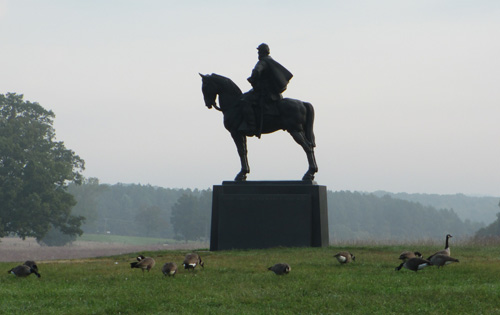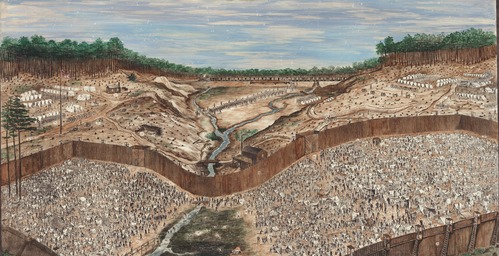Monthly Meetings
The round table meets on the third Tuesday of the month from September through May, except April, at the Bloomington Event Center, 1114 American Boulevard West, Bloomington, MN 55420, for members and their guests. Social hour starts at 5:30 pm followed by dinner and a speaker at 6:25 pm. If you are not yet a member please see Join the Table for more information or contact Jerry Ogdahl, Treasurer, at info@tccwrt.com.
For a more complete description of the program, and a speaker bio, click on the presentation title.
The Bloomington Event Center has been an excellent venue and partner to the TCCWRT, contributing to the Round Table’s health and its growth. For more information about the Bloomington Event Center, click here.

2025-2026 Guest Speaker Schedule
September 16, 2025: Nashville: Siren’s Song of the Western Confederacy – Greg Biggs
September 16, 2025
Nashville: Sirens Song of the Western Confederacy – Greg Biggs
September 16, 2025
In December, 1864, the Confederate Army of Tennessee laid siege to the massive Union fortifications and garrison of Nashville. In a two-day fight, that army was all but destroyed. Their arrival at the city’s door was the culmination of Confederate strategy that began when the city was captured by Union forces in February, 1862. Nashville, thereafter, became the “Siren’s song” for Confederate strategy in the west luring Confederate offensives no less than five times from 1862 through 1864. This program details the city’s importance and each of the five attempts to retake Nashville for the Confederacy.
Greg Biggs has studied military history for over 50 years. He is a former Associate Editor of Blue & Gray magazine, which has published several of his articles. He has also been published in Civil War Regiments, North-South Trader and Citizens’ Companion and in Sons of Confederate Veterans programs in Tennessee. He is also an authority on Civil War flags and consults with museums, auction firms, and private collectors and has contributed to books on Georgia and Tennessee Civil War flags. Greg also has done research on flags and military events for several noted Civil War authors including Eric Wittenberg, Dave Powell, Tim Smith, Gordon Rhea, Dan Masters, Art Bergeron and others. Greg is a Civil War tour guide for campaigns of the Western Theater for the U.S. Army and Civil War groups and is President of the Clarksville Civil War Roundtable as well as Program Chair of the Nashville Civil War Roundtable. He lives in Clarksville, TN with his wife Karel, a recently retired middle school teacher, and their three cats named for Civil War cavalry officers – Minty, Rucker and Ashby.


October 21, 2025: Belmont to Fort Donelson – Curt Fields as General Grant
October 21, 2025
Belmont to Fort Donelson – Curt Fields as General Grant
October 21, 2025
In November of 1861, Brigadier General U. S. Grant was ordered by Theater commander, John C. Fremont, to make a demonstration on the Mississippi river at Columbus, Kentucky and Belmont, Missouri, on the opposite side of the river. Instead, he chose to attack Belmont for several reasons, none of which he had orders to undertake. Only by the hardest, he won that fight, although some say he lost…
In February of 1863, after three more months of training at Cairo, Illinois, he was, at last, given permission by then Theater commander, Henry W. Halleck to attack Forts Henry on the Tennessee river and Fort Donelson on the Cumberland River. After Fort Henry fell easily to the navy under Flag Officer Andrew Hull Foote, Grant moved on the twelve miles between the rivers to as easily take Fort Donelson. It proved to be a substantially harder nut to crack than was Fort Henry. General Grant will relate those efforts and the frustrations involved with both weather and insubordinate subordinates.
Dr. Fields has portrayed General and President Grant in 22 states as he travels the nation presenting his portrayal of General and President Ulysses S. Grant. He researches and reads extensively about the General and President in order to deliver an accurate persona of the General.
Presentations are in first person, quoting from General Grant’s Memoirs, articles, letters and statements the General wrote, interviews he gave and first-person accounts of people who knew the General or witnessed him during events. Being the same height and body style as General Grant, he puts before the audience a convincing, true-to-life image of the man as he really looked.
In the 21st century, Curt is a retired secondary school administrator and college instructor. He also has a background in law-enforcement, having served as Memphis, TN, police officer and hostage negotiator.

November 18, 2025: The Real Horse Soldiers – Tim Smith
November 18, 2025
The Real Horse Soldiers – Tim Smith
November 18, 2024
Benjamin Grierson’s Union cavalry thrust through Mississippi is one of the most well-known operations of the Civil War. There were other simultaneous operations to distract Confederate attention from the real threat to Vicksburg posed by U. S. Grant’s Army of the Tennessee, but Grierson’s operation, mainly conducted with two Illinois cavalry regiments, has become the most famous, and for good reason. For 16 days (April 17 to May 2) Grierson led Confederate pursuers on a high-stakes chase through the entire state of Mississippi, entering the northern border with Tennessee and exiting its southern border with Louisiana. The daily rides were long, the rest stops short, and the tension high. Ironically, the man who led the raid was a former music teacher who some say disliked horses. Throughout, he displayed outstanding leadership and cunning, destroyed railroad tracks, burned trestles and bridges, freed slaves, and created as much damage and chaos as possible. Grierson’s Raid broke a vital Confederate rail line at Newton Station that supplied Vicksburg and, perhaps most importantly, consumed the attention of the Confederate high command. While Confederate Lt. Gen. John Pemberton at Vicksburg and other Southern leaders looked in the wrong directions, Grant moved his entire Army of the Tennessee across the Mississippi River below Vicksburg, spelling the doom of that city, the Confederate chances of holding the river, and perhaps the Confederacy itself. Novelists have attempted to capture the large-than-life cavalry raid in the popular imagination, and Hollywood reproduced the daring cavalry action in The Horse Soldiers, a 1959 major motion picture starring John Wayne and William Holden. Although the film replicates the raid’s drama and high-stakes gamble, cinematic license chipped away at its accuracy. Based upon years of research and presented in gripping, fast-paced prose, Timothy B. Smith’s The Real Horse Soldiers: Benjamin Grierson’s Epic 1863 Civil War Raid through Mississippi captures the high drama and tension of the 1863 horse soldiers in a modern, comprehensive, academic study. This talk, based on the book, will bring you along for the ride.
Timothy B. Smith (Ph.D. Mississippi State University, 2001) is a veteran of the National Park Service and currently teaches history at the University of Tennessee at Martin. In addition to numerous articles and essays, he is the author, editor, or co-editor of more than twenty books with several university and commercial presses. His books have won numerous book awards, his trilogy on the American Civil War’s Tennessee River campaign (Forts Henry and Donelson, Shiloh, and Corinth) winning a total of nine book awards. He has recently finished a five-volume study of the Vicksburg Campaign for the University Press of Kansas and a new study of Albert Sidney Johnston for LSU Press. He lives with his wife Kelly and daughters Mary Kate and Leah Grace in Adamsville, Tennessee.


December 16, 2025: Sherman’s Woodticks: The Remarkable Travels of the 8th MN Infantry During the Civil War – Paul Hodnefield
December 16, 2025
Sherman’s Woodtick: The Remarkable Travels of the 8th Minnesota Infantry During the Civil War – Paul Hodnefield
December 16, 2025
In August, 1862, a number of men from Monticello, greater Wright County, and surrounding areas answered the call to arm. These volunteers eventually became Company E of the Eighth Minnesota Volunteer Infantry Regiment. The Eighth Regiment had an extraordinary experience. During the last year of the Civil War, this regiment traveled more miles than any other unit, North or South. Beginning in Minnesota, they campaigned west to the Yellowstone River as part of the Dakota War and then turned around to go south through Tennessee to North Carolina. Along the way, they endured extreme weather, three train derailments and but still fought bravely when needed, including against such noted foes, as Sitting Bull and Confederate General Nathan Bedford Forrest. This is the story of the Eight Minnesota told through the eyes of the soldiers, primarily those in Company E.
Paul Hodnefield is a commercial finance attorney and skilled researcher. For as long as he can remember, Paul has had a passion for American history, with particular interest in the Revolutionary, Civil War, and frontier eras. A Minnesota native, Paul lives in the Twin Cities with his wife, Patty.


January 20, 2026: Parole of Prisoners of War in the Civil War – Stefan Lund
January 20, 2026
Parole of Prisoners of War in the Civil War – Stefan Lund, Ph.D.
January 20, 2026
At the outset of the American Civil War both factions had much they had to figure out on the fly, including what to do with the men they captured in battle. The combatants settled on a parole system, by which captured soldiers would be dismissed to return home, sworn to an oath not to take up arms again until informed that their government had agreed to exchange them for some number of their adversaries. This system broke down after President Lincoln issued the Emancipation Proclamation, as rebel leadership refused to treat Black Union soldiers as soldiers, instead threatening to enslave captured USCT soldiers and execute their white officers. The breakdown of this exchange relationship gave rise to prisoner of war camps across the country, including the notorious Andersonville prison in Georgia, as both sides found it a challenge to feed and house thousands of captured combatants. This talk will trace how the treatment of prisoners of war changed over the course of the conflict; what was the parole system, why it broke down, and the development of prison camps as a replacement. It will also highlight the soldiers’ experiences; what it meant to be captured in battle, and the experience of being paroled or imprisoned.
Stefan Lund completed his doctorate in history at the University of Virginia, where he studied at the John Nau III Center for Civil War History and received his degree in 2022. He is currently a Social Studies teacher at North Branch Area High School and produces American Ambition, a podcast about American history. He lives in Minneapolis and is an avid Twins fan.


February 17, 2026: “Had it Been a Defeat Instead, the Nation Could Have Scarcely Lived Over” Stones River 1862-1863 – Chris Kolakowski
February 17, 2026
“Had it Been a Defeat Instead, the Nation Could have Scarcely Lived Over.” Stones River 1862-1863 – Chris Kolakowski
February 17, 2026
The Battle of Stones River (December 31, 1862 – January 2, 1863) was the bloodiest battle by percentage of loss in the Civil War. It also occurred at a critical time in the war and for the United States; Abraham Lincoln believed the Union victory there may have saved the Union. This talk will explore the battle and its context.
Christopher L. Kolakowski is Director of the Wisconsin Veterans Museum in Madison, WI. He received his BA in History and Mass Communications from Emory & Henry College, and his MA in Public History from the State University of New York at Albany. Chris has spent his career interpreting and preserving American military history with the National Park Service, New York State government, the Rensselaer County (NY) Historical Society, the Civil War Preservation Trust, Kentucky State Parks, the U.S. Army, and the MacArthur Memorial. He has written and spoken on various aspects of military history from 1775 to the present and is the author of six books on the American Civil War and World War II in the Pacific. He is a contributor to the Emerging Civil War Blog, a Senior Fellow of the Consortium of Indo-Pacific Researchers, and a reviewer and contributor to the Air Force Journal of Indo-Pacific Affairs.


March 17, 2026: The Union in Peril: Lincoln and the Secession Crisis 1860-April 1861 – Ian Iverson
March 17, 2026
The Union in Peril: Lincoln and the Secession Crisis 1860-April 1861 – Ian Iverson
March 17, 2026
The election of Abraham Lincoln to the presidency in November 1860 precipitated an unprecedented national emergency. The secession of seven southern states between December and February triggered a flurry of efforts in Washington to peacefully reunite the country, even as Secessionist forces seized U.S. arsenals and menaced federal troops occupying forts in South Carolina and Florida. Within the halls of lame-duck Congress, advocates of compromise grappled with hardliners to draft legislation and constitutional amendments that would diffuse the crisis. In this lecture, Dr. Ian Iverson will outline the difficult choices facing President-elect Lincoln, detail the political machinations that stymied the so-called “Crittenden Compromise,” and walk through the chain of events that culminated in the Confederate bombardment of Fort Sumter on April 12, 1861.
Ian T. Iverson is an associate editor at the John Dickinson Writings Project. A graduate of Princeton University, he holds a Ph.D. in American history from the University of Virginia. His doctoral dissertation won the 2023 Hay-Nicolay Dissertation Prize, awarded by the Abraham Lincoln Association and the Abraham Lincoln Institute for the best dissertation on Lincoln’s legacy. His first book, Holding the Political Center in Illinois: Conservatism and Union on the Brink of the Civil War, was published by the Kent State University Press in 2024.

May 19, 2026: Held in War’s Grasp: The Ordeals of Veteranhood After the Civil War – Brian Jordan
May 19, 2026
Held in War’s Grasp: The Ordeals of Veteranhood After the Civil War
– Brian Jordan
May 19, 2026
Beginning where many histories end, Brian Matthew Jordan reveals the desperate fate that awaited Civil War veterans after demobilization. While Confederate troops returned to homes that shared in a sense of defeat, Union veterans returned to a civilian population eager to put the war behind them. Based on prodigious research in a trove of veteran correspondence, medical records, and pension files, this lecture surveys the myriad ways in which the Civil War continued to annex the bodies and minds of its survivors. Further, it reveals how the protracted battles over the conflict’s memory and legacy further complicated the onerous task of reintegration for ordinary veterans.
Brian Matthew Jordan is Associate Professor of U.S. Civil War History and Chair of the Department of History at Sam Houston State University. Professor Jordan earned his undergraduate degree in Civil War Era Studies at Gettysburg College (working under the tutelage of Gabor Boritt and Allen Guelzo), and M.A., M.Phil., and Ph.D. degrees in History at Yale. His first book, Marching Home: Union Veterans and Their Unending Civil War, was a finalist (one of three runners- up) for the 2016 Pulitzer Prize in History and, in its dissertation form, won the George Washington Egleston Prize (for Best U.S. History Dissertation at Yale) and John Addison Porter Prize. He has authored or edited five other books on Civil War soldiers, veterans, and memory, including The War Went On: Reconsidering the Lives of Civil War Veterans (with Evan Rothera); A Thousand May Fall: An Immigrant Regiment’s Civil War, and Final Resting Places: Reflections on the Meaning of Civil War Graves (with Jonathan W. White). Presently, he is at work on This War of Ours: A New History of the Civil War in the United States, a one-volume history of the conflict for Liveright/W.W. Norton. Brian is the founding co-editor of the series “Veterans” at the University of Massachusetts Press, and, for a decade, has served as Book Review Editor for The Civil War Monitor. He appears regularly on C-SPAN and was featured in the HISTORY Channel’s three-part documentary on the life of U.S. Grant. A native of Akron, Ohio, he lives in Houston with his wife and three-year old daughter, Elizabeth.
